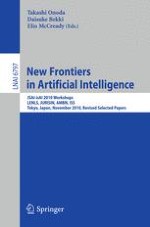2011 | Buch
New Frontiers in Artificial Intelligence
JSAI-isAI 2010 Workshops, LENLS, JURISIN, AMBN, ISS, Tokyo, Japan, November 18-19, 2010, Revised Selected Papers
herausgegeben von: Takashi Onada, Daisuke Bekki, Elin McCready
Verlag: Springer Berlin Heidelberg
Buchreihe : Lecture Notes in Computer Science
